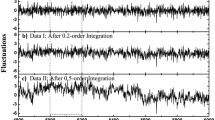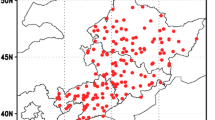Abstract
It is well recognized that climate predictability has three origins: (i) climate memory (inertia of the climate system) that accumulated from the historical conditions, (ii) responses to external forcings, and (iii) dynamical interactions of multiple processes in the climate system. However, how to systematically identify these predictable sources is still an open question. Here, we combine a recently developed Fractional Integral Statistical Model (FISM) with a Variance Decomposition Method (VDM), to systematically estimate the potential sources of predictability. With FISM, one can extract the memory component from the considered variable. For the residual parts, VDM can then be applied to extract the slow varying covariance matrix, which contains signals related to external forcings and dynamical interactions of multiple processes in climate. To demonstrate the feasibility of this new method, we analyzed the seasonal predictability in observational monthly surface air temperatures over China from 1960 to 2017. It is found that the climate memory component contributes a large portion of the seasonal predictability in the temperature records. After removing the memory component, the residual predictability stems mainly from teleconnections, i.e., in summer the residual predictability is closely related to sea surface temperature anomalies (SSTA) in the eastern tropical Pacific and the northern Indian Ocean. Our results offer the potential of more skillful seasonal predictions compared with the results obtained using FISM or VDM alone.







Similar content being viewed by others
References
Baehr J, Fröhlich K, Botzet M, Domeisen DI, Kornblueh L et al (2015) The prediction of surface temperature in the new seasonal prediction system based on the MPI-ESM coupled climate model. Clim Dyn 44:2723–2735
Brunet G, Shapiro M, Hoskins B, Moncrieff M, Dole R et al (2010) Collaboration of the weather and climate communities to advance subseasonal-to-seasonal prediction. Bull Am Meteorol Soc 91:1397–1406
Chen X, Lin GX, Fu Z (2007) Long-range correlations in daily relative humidity fluctuations: A new index to characterize the climate regions over China. Geophys Res Lett 34:L07804
Chen M, Wang W, Kumar A (2010) Prediction of monthly-mean temperature: The roles of atmospheric and land initial conditions and sea surface temperature. J Clim 23:717–725
Choi HS, Schneider UA, Rasche L, Cui J, Schmid E, Held H (2015) Potential effects of perfect seasonal climate forecasting on agricultural markets, welfare and land use: a case study of Spain. Agric Syst 133:177–189
Davies HC (2015) Weather chains during the 2013/2014 winter and their significance for seasonal prediction. Nat Geosci 8:833–837
Doi T, Behera SK, Yamagata T (2016) Improved seasonal prediction using the SINTEX-F2 coupled model. J Adv Model Earth Syst 8:1847–1867
Duan W, Song L, Li Y, Mao J (2013) Modulation of PDO on the predictability of the interannual variability of early summer rainfall over south China. J Geophys Res Atmos 118(23):13008–13021
Fraedrich K, Blender R (2003) Scaling of atmosphere and ocean temperature correlations in observations and climate models. Phys Rev Lett 90:108501
Fraedrich K, Luksch U, Blender R (2004) 1/f model for long-time memory of the ocean surface temperature. Phys Rev E 70:037301
Franzke CLE (2017) Impacts of a changing climate on economic damages and insurance. Econ Disaster Clim Change 1:95–110
Franzke CLE, Osprey SM, Davini P, Watkins NW (2015) A dynamical systems explanation of the Hurst effect and atmospheric low-frequency variability. Sci Rep 5:9068
Franzke CLE, Barbosa S, Blender R, Fredriksen H-B, Laepple T, Lambert F et al (2020) The structure of climate variability across scales. Rev Geophys 58:e2019RG000657
Frederiksen CS, Ying K, Grainger S, Zheng X (2018) Modes of interannual variability in northern hemisphere winter atmospheric circulation in CMIP5 models: evaluation, projection and role of external forcing. Clim Dyn 50:2845–2865
Fredriksen H-B, Rypdal K (2016) Spectral characteristics of instrumental and climate model surface temperatures. J Clim 29:1253–1268
Fredriksen H-B, Rypdal M (2017) Long-range persistence in global surface temperatures explained by linear multibox energy balance models. J Clim 30:7157–7168
Hasselmann K (1976) Stochastic climate models part I. Theory Tellus 28:473–485
He Z, Wu R (2014) Indo-Pacific remote forcing in summer rainfall variability over the South China Sea. Clim Dyn 42:2323–2337
He Q, Zuo Z, Zhang R, Zhang R (2018) Seasonal prediction and predictability of eurasian spring snow water equivalent in NCEP climate forecast system version 2 reforecasts. Clim Dyn 50:339–348
Jiang L, Yuan N, Fu Z, Wang D, Zhao X, Zhu X (2012) Subarea characteristics of the long-range correlations and the index \(\chi\) for daily temperature records over China. Theor Appl Climatol 109:261–270
Jiang L, Li N, Zhao X (2017) Scaling behaviors of precipitation over China. Theor Appl Climatol 128:63–70
Kantelhardt JW, Koscielny-Bunde E, Rego HHA, Havlin S (2001) Detecting long-range correlations with detrended fluctuation analysis. Phys A 295:441–454
Kim H, Webster PJ, Curry JA (2012) Seasonal prediction skill of ECMWF system 4 and NCEP CFSv2 retrospective forecast for the northern hemisphere winter. Clim Dyn 39:2957–2973
Koscielny-Bunde E, Bunde A, Havlin S, Roman HE, Goldreich Y, Schellnhuber HJ (1998) Indication of a universal persistence law governing atmospheric variability. Phys Rev Lett 81:729–732
Kurnaz ML (2004) Application of detrended fluctuation analysis to monthly average of the maximum daily temperatures to resolve different climates. Fractals 12:365–373
Li Y, Li J, Feng J (2013) Boreal summer convection oscillation over the Indo-Western Pacific and its relationship with the East Asian summer monsoon. Atmos Sci Lett 14:66–71
Liu SF, Duan AM (2017) A statistical forecast model for summer precipitation in eastern China based on spring sensible heat anomaly in the Tibetan Plateau. Acta Meteorol Sin 75:903–916
Liu Y, Fan K (2012) Improve the prediction of summer precipitation in the Southeastern China by a hybrid statistical downscaling model. Meteorol Atmos Phys 117(3–4):121–134
Liu YM, Liu BQ, Ren RC, Duan AM, Mao JY (2016) Current super El Ni\(\tilde{n}\)o event and its impacts on climate in China in spring and summer. Bull Chin Acad Sci 31(2):241–250
Lovejoy S, del Rio Amador L, Hébert R (2015) The Scaling Linear macroweather model (SLIM): using scaling to forecast global scale macroweather from months to decades. Earth Syst Dyn 6:637–658
MacLeod DA, Jones A, Di Giuseppe F, Caminade C, Morse AP (2015) Demonstration of successful malaria forecasts for Botswana using an operational seasonal climate model. Environ Res Lett 10:044005
National Academies of Sciences, Engineering, and Medicine (2016) Next generation earth system prediction: strategies for subseasonal to seasonal forecasts. National Academies Press, Washington DC, p 350
National Research Council (2010) Assessment of intra-seasonal to inter-annual climate prediction and predictability. National Academies Press, Washington, DC, p 192
Peng CK, Buldyrev SV, Havlin S, Simons M, Stanley HE, Goldberger AL (1994) Mosaic organization of DNA nucleotides. Phys Rev E 49:1685–1689
Pokhrel S, Saha SK, Dhakate A, Rahman H, Chaudhari HS et al (2016) Seasonal prediction of Indian summer monsoon rainfall in NCEP CFSv2: forecast and predictability error. Clim Dyn 46:2305–2326
Qiu M, Yuan N, Yuan S (2020) Understanding long-term memory in global mean temperature: an attribution study based on model simulations. Atmos Oceanic Sci Lett (in press)
Rayner NAA, Parker DE, Horton EB, Folland CK, Alexander LV et al (2003) Global analyses of sea surface temperature, sea ice, and night marine air temperature since the late nineteenth century. J Geophys Res Atmos 108:4407
Rybski D, Bunde A, von Storch H (2008) Long-term memory in 1000-year simulated temperature records. J Geophys Res 113:D02106
Smith DM, Scaife AA, Kirtman BP (2012) What is the current state of scientific knowledge with regard to seasonal and decadal forecasting? Environ Res Lett 7:015602
Tadesse T, Haigh T, Wall N, Shiferaw A, Zaitchik B et al (2016) Linking seasonal predictions to decision-making and disaster management in the Greater Horn of Africa. Bull Am Meteorol Soc 97:ES89–ES92
Thornton H, Scaife A, Hoskins B, Brayshaw D, Smith D et al (2019) Skilful seasonal prediction of winter gas demand. Environ Res Lett 14:24009
Tommasi D, Stock CA, Pegion K, Vecchi GA, Methot RD, Alexander MA, Checkley DM (2017) Improved management of small pelagic fisheries through seasonal climate prediction. Ecol Appl 27:378–388
Vyushin DI, Kushner PJ (2009) Power-law and long-memory characteristics of the atmospheric general circulation. J Clim 22:2890–2904
Vyushin DI, Zhidkov I, Havlin S, Bunde A, Brenner S (2004) Volcanic forcing improves atmosphere-ocean coupled general circulation model scaling performance. Geophys Res Lett 31:L10206
Xie SP, Kosaka Y, Du Y, Hu K, Chowdary JS, Huang G (2016) Indo-western Pacific ocean capacitor and coherent climate anomalies in post-ENSO summer: A review. Adv Atmos Sci 33(4):411–432
Xie F, Yuan N, Qi Y, Wu W (2019) Is long-term climate memory important in temperature/precipitation predictions over China? Theor Appl Climatol 137:459–466
Ying K, Zheng X, Quan XW, Frederiksen CS (2013) Predictable signals of seasonal precipitation in the Yangtze-Huaihe River Valley. Int J Climatol 33:3002–3015
Ying K, Zhao T, Quan XW, Zheng X, Frederiksen CS (2015) Interannual variability of autumn to spring seasonal precipitation in eastern China. Clim Dyn 45:253–271
Ying K, Zhao T, Zheng X, Quan XW, Frederiksen CS, Li M (2016) Predictable signals in seasonal mean soil moisture simulated with observation-based atmospheric forcing over China. Clim Dyn 47:2373–2395
Ying K, Zheng X, Zhao T, Frederiksen CS, Quan X (2017) Identifying the predictable and unpredictable patterns of spring-to-autumn precipitation over eastern china. Clim Dyn 48:3183–3206
Yuan X, Wood EF, Luo L, Pan M (2011) A first look at climate forecast system version 2 (CFSv2) for hydrological seasonal prediction. Geophys Res Lett 38:L13402
Yuan N, Fu Z, Liu S (2013) Long-term memory in climate variability: A new look based on fractional integral techniques. J Geophys Res 118:12962–12969
Yuan N, Fu Z, Liu S (2014) Extracting climate memory using fractional integrated statisitcal model: a new perspective on climate prediction. Sci Rep 4:6577
Yuan N, Ding M, Huang Y, Fu Z, Xoplaki E, Luterbacher J (2015) On the long-term climate memory in the surface air temperature records over Antarctica: a nonnegligible factor for trend evaluation. J Clim 28:5922–5934
Yuan N, Huang Y, Duan J, Zhu C, Xoplaki E, Luterbacher J (2019) On climate prediction: how much can we expect from climate memory? Clim Dyn 52:855–864
Zheng X, Frederiksen CS (2004) Variability of seasonal-mean fields arising from intraseasonal variability: part 1, methodology. Clim Dyn 23:177–191
Acknowledgements
Many thanks are due to the support from the National Natural Science Foundation of China (No.41675088) and from the National Key R&D Program of China (2016YFA0600404). YQ was supported by the National Natural Science Foundation of China (No. 41675068). CF was partially supported by the Collaborative Research Centre TRR 181 “Energy Transfer in Atmosphere and Ocean”, funded by the Deutsche Forschungsgemeinschaft (DFG, German Research Foundation, No.274762653). NY thanks also the support from the CAS Pioneer Hundred Talents Program.
Author information
Authors and Affiliations
Corresponding author
Additional information
Publisher's Note
Springer Nature remains neutral with regard to jurisdictional claims in published maps and institutional affiliations.
Electronic supplementary material
Below is the link to the electronic supplementary material.
Rights and permissions
About this article
Cite this article
Nian, D., Yuan, N., Ying, K. et al. Identifying the sources of seasonal predictability based on climate memory analysis and variance decomposition. Clim Dyn 55, 3239–3252 (2020). https://doi.org/10.1007/s00382-020-05444-7
Received:
Accepted:
Published:
Issue Date:
DOI: https://doi.org/10.1007/s00382-020-05444-7




